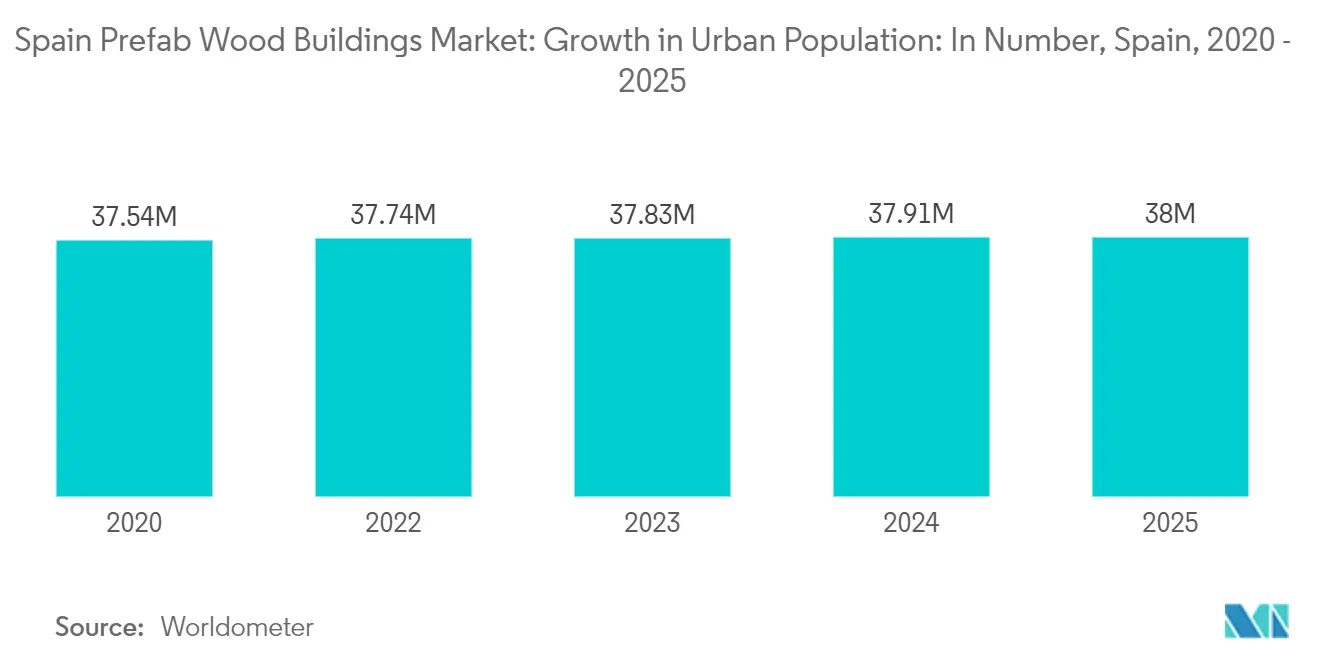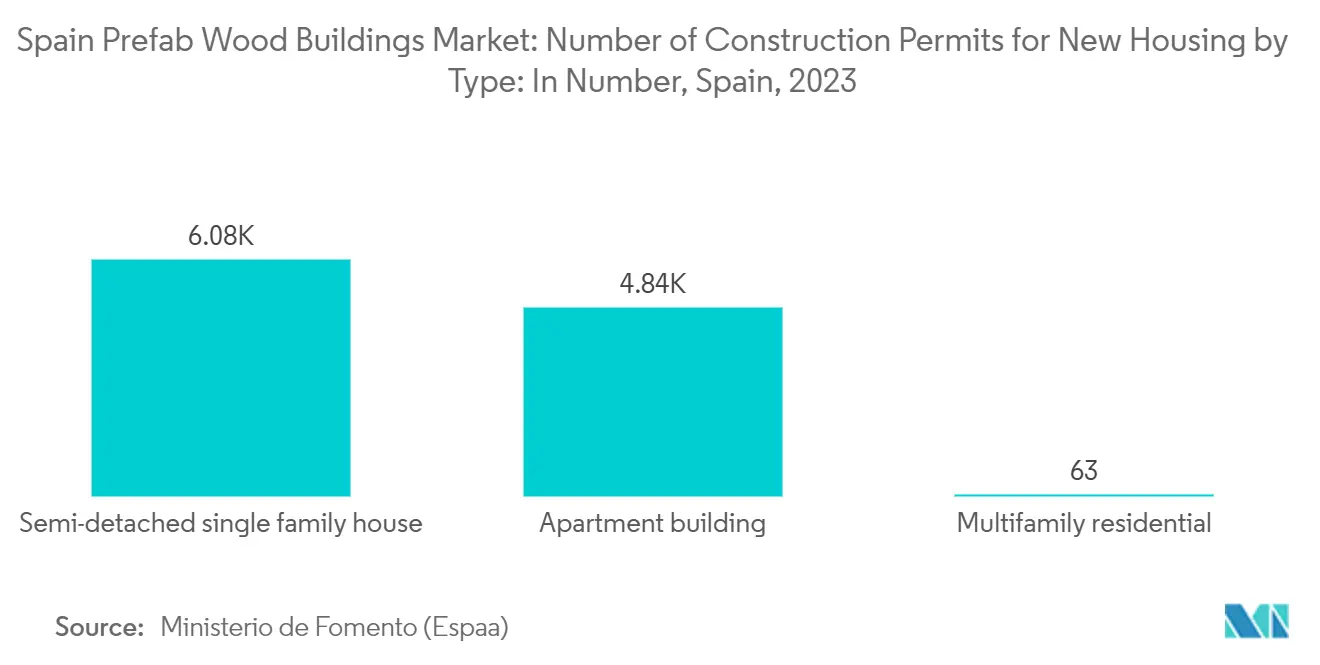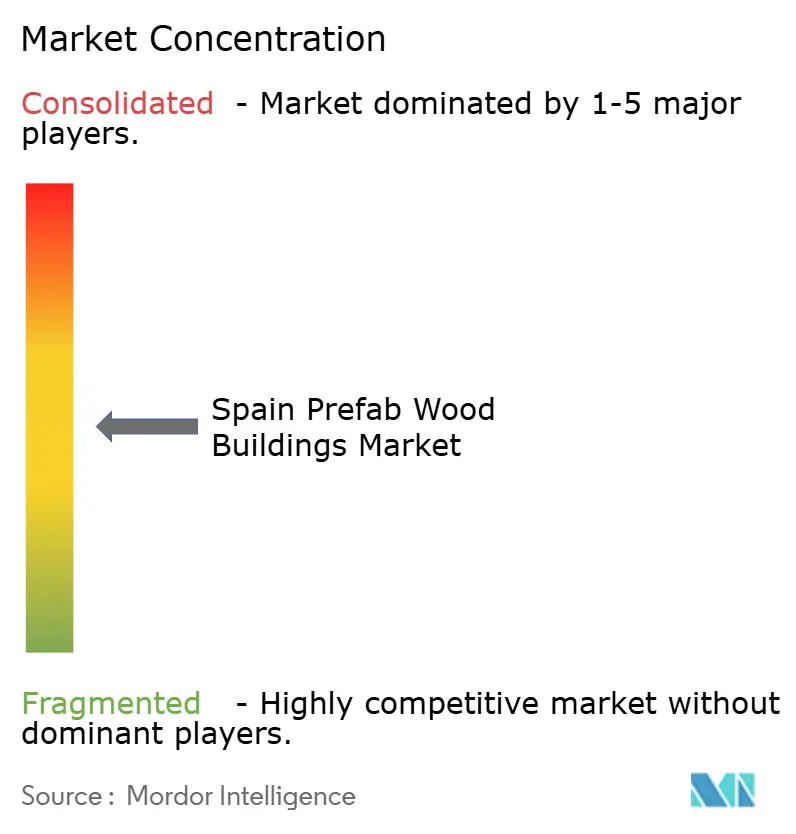
Spain Prefab Wood Buildings Market Analysis by Mordor Intelligence
The Spain Prefab Wood Buildings Market is expected to register a CAGR of greater than 5.38% during the forecast period.
- The Spanish prefabricated wood buildings market is experiencing growth, particularly in urban areas like Madrid and Barcelona, driven by the need for efficient and sustainable housing solutions. Coastal regions are also seeing increased demand, fueled by the expanding tourism sector and the need for cost-effective accommodation. The adoption of cross-laminated timber (CLT) has significantly improved the durability and appeal of these structures, positioning them as a viable alternative in the construction industry. However, limited awareness and lingering misconceptions about prefabricated wood buildings remain challenges for market expansion.
- In January 2025, the Spanish government introduced a project to modernize the industrialized and modular construction sector, aiming to deliver faster and more affordable housing. Reforms to the Land Law and a EUR 6 billion (USD 6.19 billion) allocation in ICO credits and guarantees are set to support the construction of 25,000 new homes. This initiative underscores a collaborative effort between public entities and private developers to address the housing deficit effectively.
- Technological advancements are playing a pivotal role in the market's growth. Building Information Modeling (BIM) has enhanced design accuracy and project efficiency, while automated manufacturing has streamlined production processes and ensured consistency. Additionally, 3D printing has enabled the creation of customized components with minimal waste, further improving the quality and cost-effectiveness of prefabricated wood buildings.
- In conclusion, the Spanish prefabricated wood buildings market is poised for significant growth, driven by government support, technological advancements, and increasing demand for sustainable housing solutions. Addressing awareness challenges and misconceptions will be critical to unlocking the market's full potential in the coming years.
Spain Prefab Wood Buildings Market Trends and Insights
Urbanization and Population Growth Fuel Demand for Prefab Wood Buildings
Urbanization and population growth are driving significant changes in the prefabricated wood buildings market, particularly in Spain. The rising need for housing and infrastructure due to expanding urban areas and increasing populations has intensified the focus on efficient and sustainable construction solutions. Prefabricated wood buildings are gaining traction as they offer rapid assembly, cost-effectiveness, and environmental benefits.
For instance, in November 2024, Spain faced a pressing requirement for 600,000 new homes by 2025 to address growing housing demands and stabilize prices. This situation has pushed the construction industry to adopt innovative building methods, with prefabricated wood structures becoming a key solution. Spanish cities, including Barcelona, have been influenced by successful European housing models that prioritize sustainability and community-oriented designs. These projects often incorporate environmentally friendly materials like timber, communal spaces, and energy-efficient features, which are shaping the adoption of prefabricated wood construction in Spain.
The evolving housing needs and the emphasis on sustainable construction are expected to significantly impact the growth of the prefabricated wood buildings market in Spain. The adoption of these structures aligns with the country's efforts to address housing shortages while promoting environmentally responsible practices, positioning prefabricated wood buildings as a vital component of Spain's construction landscape.

Spain's Single-Family Homes Drive Surge in Prefabricated Building Market
In Spain, the single-family residential sector is significantly influencing the evolution of the prefabricated wood buildings market. The sector's growing preference for prefabricated construction methods is attributed to the need for efficient, cost-effective, and sustainable housing solutions. These methods enable rapid assembly, ensure high-quality standards, and allow for customization, making them a preferred choice for single-family homes.
In December 2024, Homm, a real estate company specializing in prefabricated homes, delivered 26 new single-family houses in Madrid. Over the past two years, the company expanded the city's housing stock with 75 prefabricated semi-detached houses and initiated the assembly of a new development comprising 21 homes. In September 2024, prefabricated homes priced around EUR 20,000 (USD 20,618) gained traction in Spain, reflecting a growing demand for affordable and efficient housing options. The market is witnessing a shift, with expectations that 40% of homes in Spain could be prefabricated by 2030, driven by reduced construction times, lower costs, flexibility, customization options, and superior energy efficiency.
In August 2024, a prefabricated house priced at EUR 15,000 (USD 15,463.50) became available on Amazon Spain. Constructed with a steel frame and fireproof foam wall panels, the house offers waterproofing, thermal insulation, and resistance to earthquakes and strong winds. Its design includes multiple windows for natural light and complete electrical wiring, making it suitable for use as a primary residence, second home, or office. These developments highlight the increasing adoption of prefabricated wood buildings in Spain, showcasing their versatility and alignment with modern housing needs.
The ongoing advancements in prefabricated construction methods and their growing acceptance in the single-family residential sector are expected to play a pivotal role in shaping the future of Spain's prefabricated wood buildings market.

Competitive Landscape
The Spain prefab wood building market is semi-consolidated, comprising a mix of established companies and emerging players. Key participants such as Tokamadera Estructuras Modulares S.L., Cabisuar SA, Viprehome, Balat, and Canval Empresa Constructora, S.L. play a significant role in shaping the market. The combination of experienced firms and new entrants fosters competition, driving innovation and offering diverse solutions in prefabricated wood construction. This market structure ensures stability while addressing varied consumer preferences and project needs.
Government initiatives, including the proposed 100% personal income tax exemption for homeowners renting properties at the Reference Price Index starting January 2025, aim to promote affordable rentals. These measures are expected to increase demand for cost-effective prefabricated wood housing in Spain.
Spain Prefab Wood Buildings Industry Leaders
-
Tokamadera Estructuras Modulares S.l
-
Cabisuar SA
-
Viprehome
-
Balat
-
Canval Empresa Constructora, S.L
- *Disclaimer: Major Players sorted in no particular order

Recent Industry Developments
- January 2025: The government announced the PERTE de Viviendas project to promote innovation and modernization in industrialized and modular construction. The initiative aimed to improve efficiency and reduce costs in housing construction, directly supporting the growth of the prefabricated wood building market in Spain.
- January 2025: Investment funds Hines and Starwood Capital expressed interest in acquiring Aedas Homes, a Spanish residential developer, in a deal valued at over EUR 1.1 billion (USD 1.13 billion), with binding offers expected in February 2025. This highlighted increased investor activity in Spain's housing market, which can impact the prefabricated wood building market.
Spain Prefab Wood Buildings Market Report Scope
The prefab wood buildings market encompasses the design, manufacture, and assembly of wooden structures, crafted in factories and then transported for installation. These structures range from residential homes and commercial spaces to modular designs, predominantly utilizing engineered or solid wood. Sustainability trends, cost-effectiveness, and quicker construction timelines fuel the market's growth, outpacing traditional methods. Moreover, technological strides in prefabrication and a rising preference for eco-friendly materials further mold the market landscape. Key industry players span design, manufacturing, and on-site assembly, addressing diverse end-user demands.
The Spain prefab wood buildings market is segmented by panel systems (Cross-Laminated Timber (CLT) panels, Nail-Laminated Timber (NLT) panels, Dowel-Laminated Timber (DLT) panels, and Glue-Laminated Timber (GLT) columns and beams), and by application (single family residential, multi-family residential, office, and hospitality). The report offers market size and market forecasts for Spain prefab wood buildings market in value (USD).
| Cross-laminated timber (CLT) panels |
| Nail-laminated timber (NLT) panels |
| Dowel-laminated timber (DLT) panels |
| Glue-laminated timber (GLT) columns and beams |
| Single Family Residential |
| Multi-family Residential |
| Office |
| Hospitality |
| Others |
| Panel Systems | Cross-laminated timber (CLT) panels |
| Nail-laminated timber (NLT) panels | |
| Dowel-laminated timber (DLT) panels | |
| Glue-laminated timber (GLT) columns and beams | |
| Application | Single Family Residential |
| Multi-family Residential | |
| Office | |
| Hospitality | |
| Others |
Key Questions Answered in the Report
What is the current Spain Prefab Wood Buildings Market size?
The Spain Prefab Wood Buildings Market is projected to register a CAGR of greater than 5.38% during the forecast period (2025-2030)
Who are the key players in Spain Prefab Wood Buildings Market?
Tokamadera Estructuras Modulares S.l, Cabisuar SA, Viprehome, Balat and Canval Empresa Constructora, S.L are the major companies operating in the Spain Prefab Wood Buildings Market.
What years does this Spain Prefab Wood Buildings Market cover?
The report covers the Spain Prefab Wood Buildings Market historical market size for years: 2019, 2020, 2021, 2022, 2023 and 2024. The report also forecasts the Spain Prefab Wood Buildings Market size for years: 2025, 2026, 2027, 2028, 2029 and 2030.
Page last updated on:
Spain Prefab Wood Buildings Market Report
Statistics for the 2025 Spain Prefab Wood Buildings market share, size and revenue growth rate, created by Mordor Intelligence™ Industry Reports. Spain Prefab Wood Buildings analysis includes a market forecast outlook for 2025 to 2030 and historical overview. Get a sample of this industry analysis as a free report PDF download.



